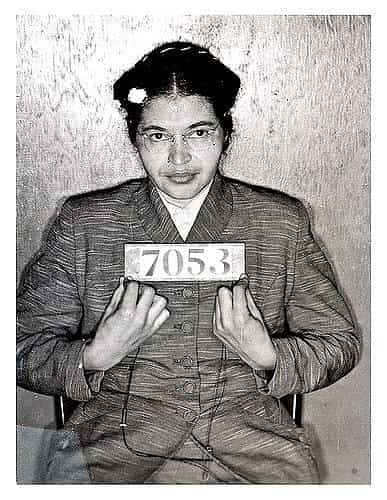Introduction - Montgomery Bus Boycott
Sparked by the arrest of Rosa Parks on December 1st of 1955 for not giving her seat up to a white passenger on a Montgomery Alabama city bus the Montgomery Bus Boycott
was the first major non-violent civil-rights protest against racial segregation in the United States. This important event in black history would ignite the civil
rights movement and prompt numerous other protest that would culminate in the Civil Rights Act of 1964 making racial segregation illegal.
Click here for a great selection of Amazon.com
books about the Montgomery bus boycott.
In 1955 racial segregation was the norm in the southern United States. White people and black people had separate water fountains, sections of movie theatres, lunch counters, bus seats, and separation in other public places. This separate but equal policy was considered legal and its legality had been supported by the courts. However this policy fostered inequality and racial discrimination.
On this page we list interesting facts about the Montgomery Bus Boycott including who the protesters were, why it was successful, and how it thrust a young preacher named Martin Luther King, Jr into the spotlight of the fight for civil rights. This information is written for kids who may be writing Black History Month reports and for adults wanting to learn more about this important and famous event in black history.
Interesting Montgomery Bus Boycott Facts
- After Rosa Park's arrest civil rights organizations began handing out flyers calling for a boycott of the Montgomery bus system starting on December 5th (1955) the day Parks was to appear in municipal court.
- In the days between Park's arrest on December 1st and the start of the boycott on December 5th a massive effort took place in Montgomery to make the black community aware of the boycott and to encourage their participation. Black ministers encouraged their congregations to participate and a newspaper, the Montgomery Advertiser, ran a front-page article about the pending boycott.
- More than 75 percent of the city's bus riders were black.
- The Montgomery Bus Boycott began on December 5th of 1955 which was 4 days after Rosa Parks was arrested for not giving up her bus seat to a white passenger.
- The overwhelming majority of black bus riders in Montgomery, approximately 40,000, participated in the boycott starting on December 5th. Many joined car pools in order to get to work and some even walked miles to work and other destinations. Montgomery African-American taxi drivers helped the cause by reducing their fair for black riders to ten cents, the same amount as a bus fare.
- On the first day of the boycott the Montgomery Improvement Association (MIA) was formed for the purpose of guiding the boycott. The MIA's leaders were Ralph Abernathy, Edgar Nixon, and a young determined preacher named Martin Luther King, Jr. who was elected as the organizations president.
- Black leaders, including Martin Luther King, Jr., did an excellent job in keeping the boycott going. They helped organize car pools and held numerous mass meetings encouraging the protesters to continue the boycott.
- The boycott leaders demanded the Montgomery busing segregation laws be eliminated. However the city held out even under the incredible loss in revenue from bus fares.
- Martin Luther King, Jr and many other leaders of the boycott were arrested for conspiring to interfere with a business. He spent two weeks in jail.
- In November of 1956 the United States Supreme Court, upholding a district court's decision challenged by the city of Montgomery, stated that Alabama's racial segregation of buses was unconstitutional. This ruling went into effect on December 20th of 1956 meaning from there on black bus passengers could sit in any open bus seat.
- It had taken 381 days but the Montgomery Bus Boycott was successful in ending segregation on buses and showed how economic boycotts by the African-American population could lead to great results in the battle for civil rights.
- Martin Luther King's leadership during the Montgomery Bus Boycott established him as a leader of the civil rights movement.
- The de-segregation of the Montgomery buses was met with great violence. Several buses were shot at, black leaders homes and churches were bombed. A bomb placed at Martin Luther King's house was defused. Several members of the white supremacist group the Ku Klux Klan were eventually arrested for setting bombs upon which the violence, for the most part, died down.
